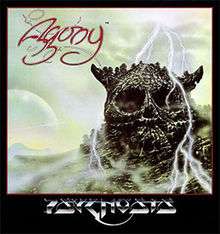Agony (1992 video game)
Agony is a horizontally scrolling shooter with a surreal fantasy background. It was released by Psygnosis in 1992 for the Amiga.[1] Agony features a barn owl flying its way through six worlds filled with monsters. The owl uses various waves of echolocation which the player fires at the enemies.
| Agony | |
|---|---|
 Cover art by Roger Dean | |
| Developer(s) | Art & Magic |
| Publisher(s) | Psygnosis |
| Designer(s) | Yves Grolet |
| Platform(s) | Amiga |
| Release |
|
| Genre(s) | Scrolling shooter |
| Mode(s) | Single-player |
Plot
According to the manual backstory, the sun-wizard master Acanthopsis discovers the "Cosmic Power" with a toll on his life. Before dying he teaches it to his disciples, Alestes and Mentor. Alestes has been transformed into a barn owl, and has to pass through Mentor's traps and monsters in order to reach the Cosmic Power.
Development
The game makes great use of many Amiga features such as scales of colors done with raster lines, halfbrite graphics mode for the between-level pictures, three layers of parallax scrolling using dual-playfield mode, in-game palette swapping and continuous flashing of the background palette to simulate additional colors. Featuring three floppies, the game ran on all Amiga computers. In common with other Amiga titles, the music was created with sampled sounds.
Music
The theme song is by Tim Wright, a classically themed, piano-led instrumental. The title song was adapted without giving him proper credit by the keyboardist of Dimmu Borgir in the song "Sorgens Kammer" for their Stormblåst album.[2] The band did not know about this. Following several months of communication between Wright and Dimmu Borgir, and in a nod to the composer, the band did not include the track on a later re-recording of Stormblåst.[3] The title song is also slightly different from the version that Wright originally submitted to Art & Magic. Franck Sauer advised Wright that he could source improved piano sounds for the piece, and requested permission to change them. Wright agreed, but did not hear the end result before the game went to the final master, and consequently some notes within the piece were transposed; this 'mistake' was also covered by Dimmu Borgir.[2]